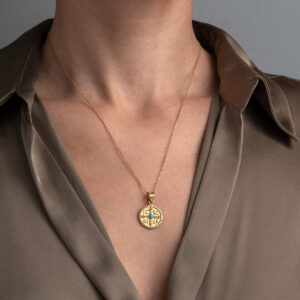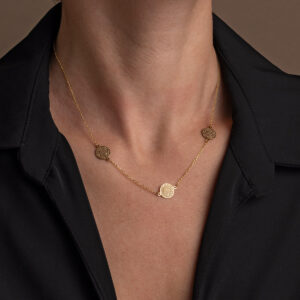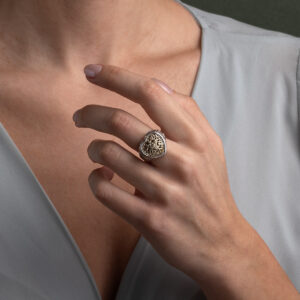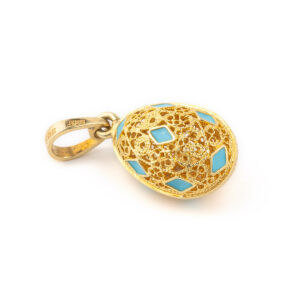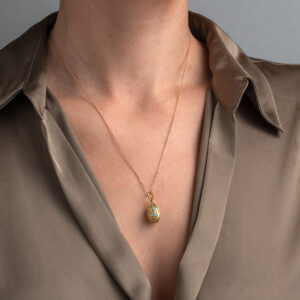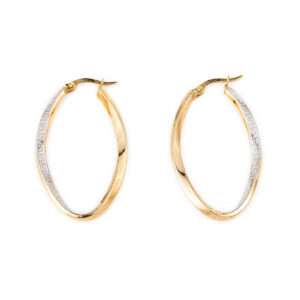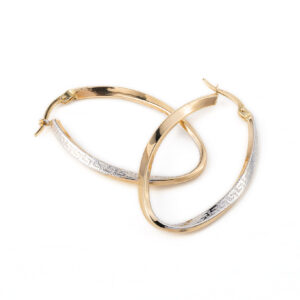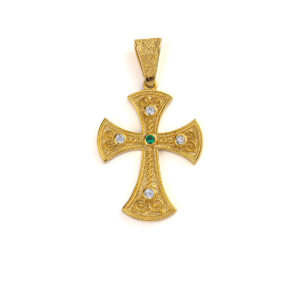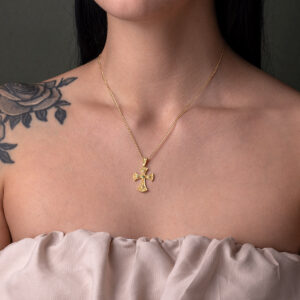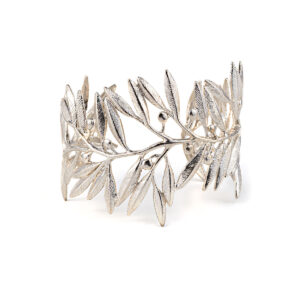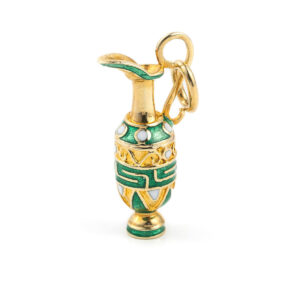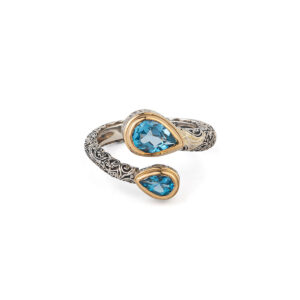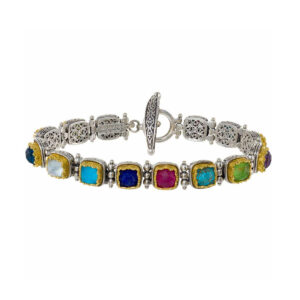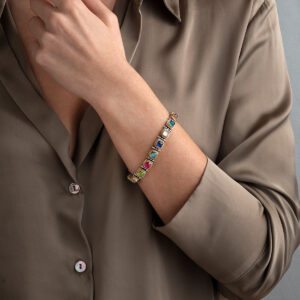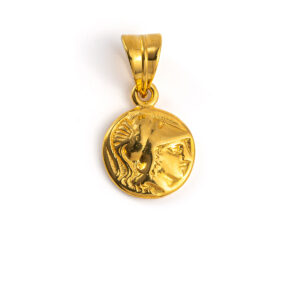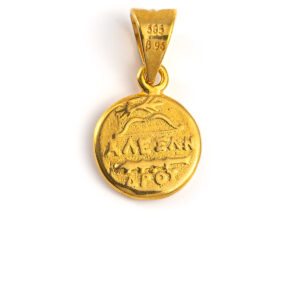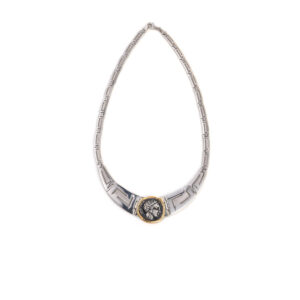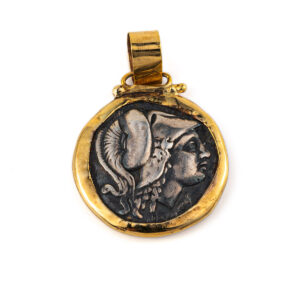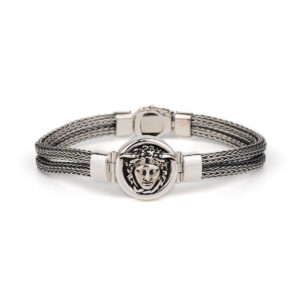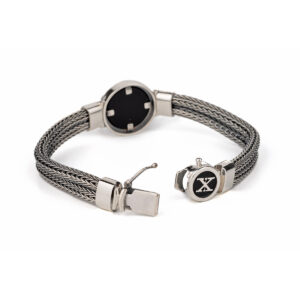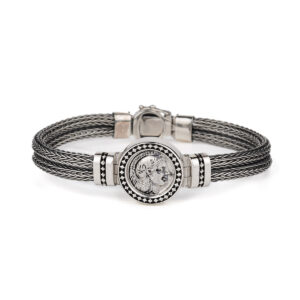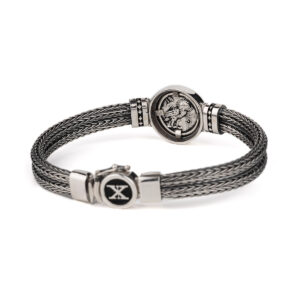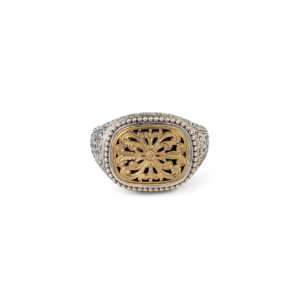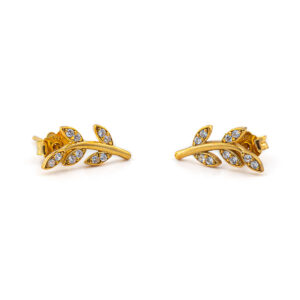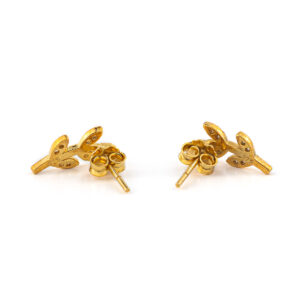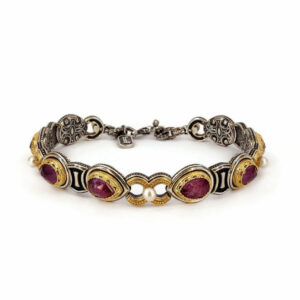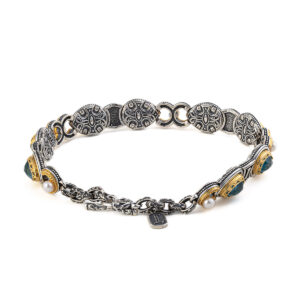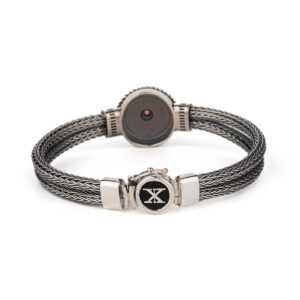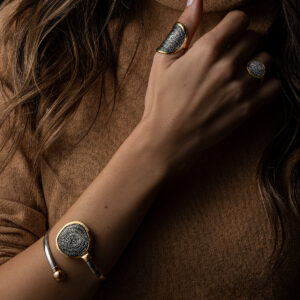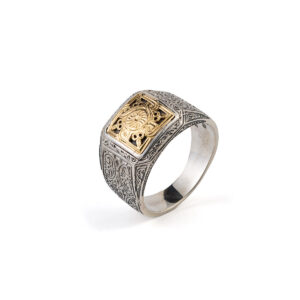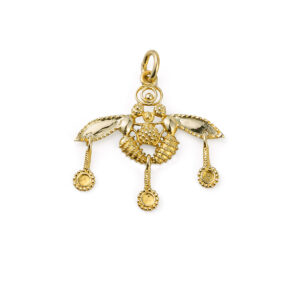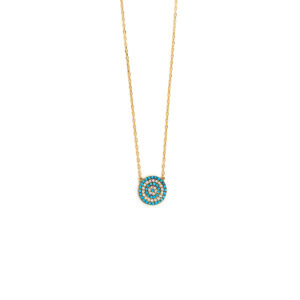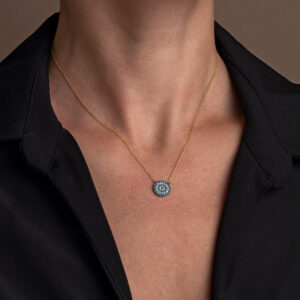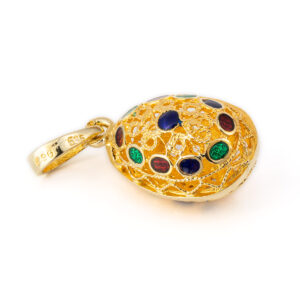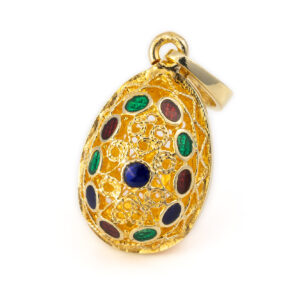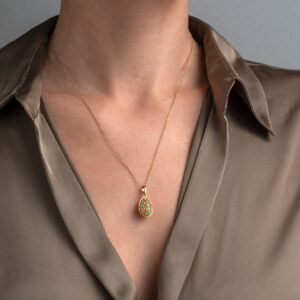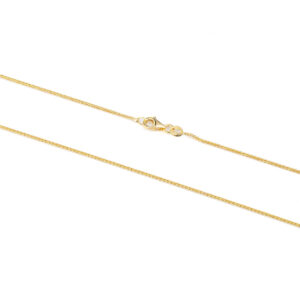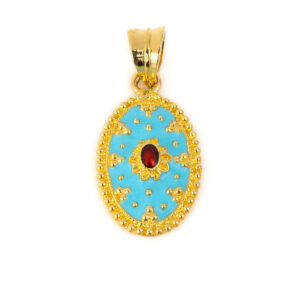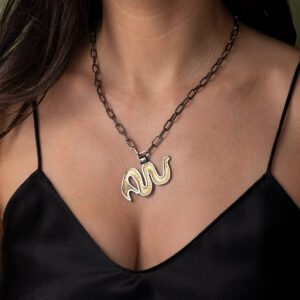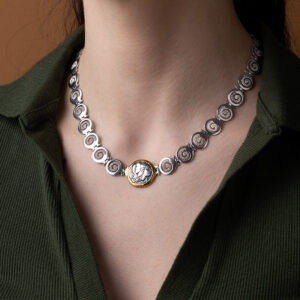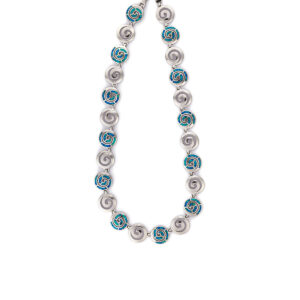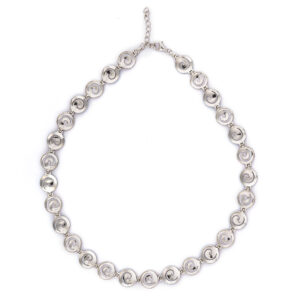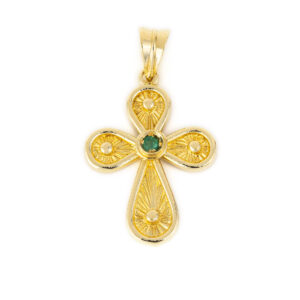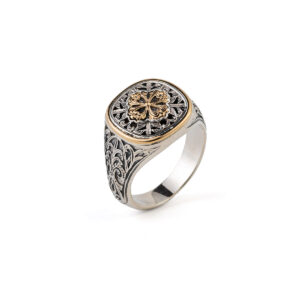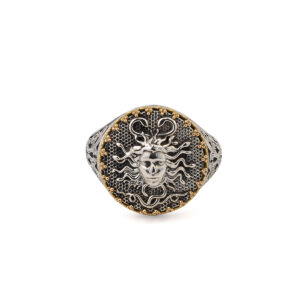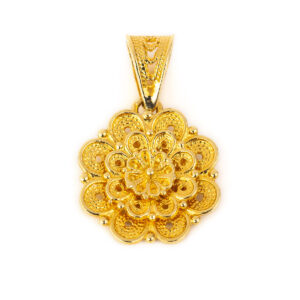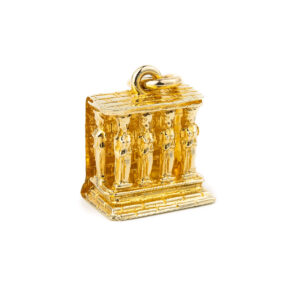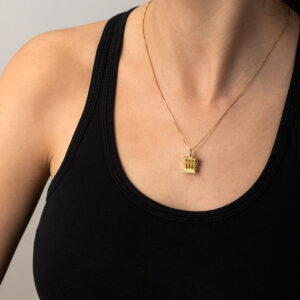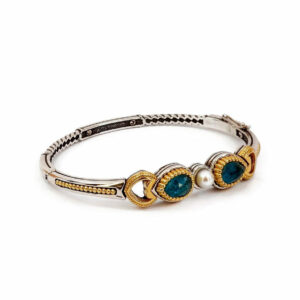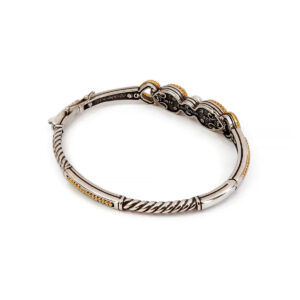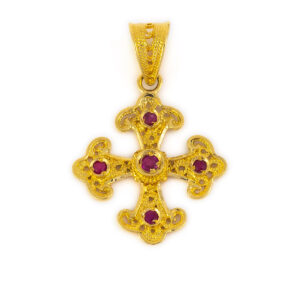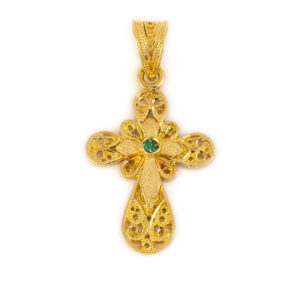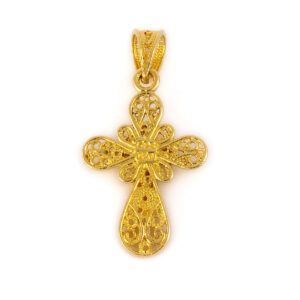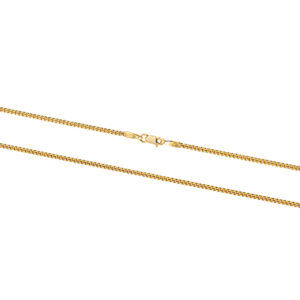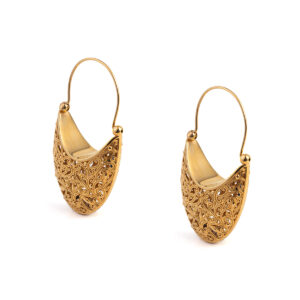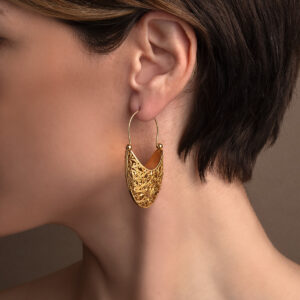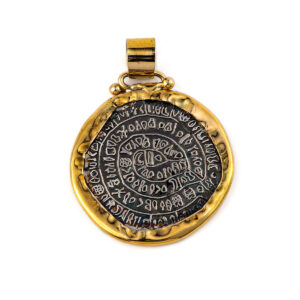Constantinato Pendant with Turquoise – Gold 14K
605,00€A handmade gold Constantinato pendant that depicts a cross on the one side and Saints Constantine and Helena on the other side.
A unique pendant that you can offer to your special ones as a protection gift or buy it for yourself.
Made of 14k gold.
Handmade in Greece.
The chain shown is our Cable Chain in 14K Gold (not included).
14K Gold Phaistos Disk Necklace
605,00€This beautiful necklace represents the disc of Phaistos. The Phaistos Disc is a disk of fired clay from the Minoan palace of Phaistos on the island of Crete. Now, the island of Crete is part of modern Greece. The disc was discovered in 1908 by the Italian archaeologist Luigi Pernier in the Minoan palace-site of Phaistos. While it is not clear that it is a script, most attempted decipherments assume that it is; most additionally assume a syllabary, others an alphabet or logography or a calendar, making it one of the most famous mysteries of archaeology. The disk is about 15 cm in diameter and covered on both sides with a spiral of stamped symbols. The disc features 241 tokens, comprising 45 distinct signs, which were apparently made by pressing hieroglyphic “seals” into a disc of soft clay, in a clockwise sequence spiraling toward the center of the disk. This unique object is now on display at the Archaeological Museum of Heraklion.
Made in 14k gold.
Handmade item. As in all handmade items, there may be small differences in weight and dimensions and this is what makes them unique and precious.
Gerochristo – Mediterranean heart Ring in 18K Gold and Sterling Silver
602,00€Embrace elegance with the Gerochristo Mediterranean Heart Ring, a stunning fusion of 18K gold and sterling silver. This exquisite ring, featuring a striking heart motif, symbolizes love and is perfect for those who appreciate the finer things in life. The heart, crafted in radiant 18K gold, sits beautifully on a bed of intricately designed sterling silver, reflecting the charm of the Mediterranean.
The ring’s band, made from high-quality sterling silver, boasts elegant details, enhancing its overall allure. The contrast of the warm gold heart against the cool silver band adds a touch of sophistication, making this ring a versatile piece for any outfit.
Ideal for special occasions, as a gift of love, or as a luxurious treat to yourself, the Gerochristo Mediterranean Heart Ring is more than just a piece of jewelry. It symbolizes enduring style and timeless elegance, promising a cherished addition to any collection.
Ring in 18K solid Yellow Gold and sterling silver. Handcrafted jewelry made in Greece. The sterling silver band, adorned with delicate, handcrafted patterns, whispers tales of ancient romance and enduring beauty. The harmonious blend of gold and silver is a meeting of metals and a fusion of stories, dreams, and passions. Perfect for those who hold the Mediterranean close to their heart, this ring is more than a jewel; it’s a poetic embrace, a keepsake of love that resonates with the rhythm of the waves and the sun’s warmth.
Gerochristo Rings are famous for their unique design. All rings are a circle without end, echoing the eternal nature of love, the unbroken promise between two hearts. The perfect circle aligns with its symbolism – a never-ending loop reflecting infinite love and unyielding commitment. Rings are a reminder of that boundless love, a physical embodiment of the depth and magnitude of feelings that words can only begin to describe. In its simple elegance lies the promise of forever, a vow as deep and vast as the sea.
Handcrafted jewelry made in Greece.
Explore Valentine Collection by Gerochristo
14k Gold Filigree Egg Pendant with Turquoise enamel
602,00€The pendant is embellished with fine filigree and turquoise enamel in Faberge style. Also, the pendant is decorated with a floral design.
Used as a charm or as a pendant.
Pick up a beautiful gift inspired by the majestic art of Fabergé!
Made in 14k yellow gold.
The chain shown is our Cable Chain in 14K Gold (not included).
Filigree is a delicate kind of jewelry metalwork, made with tiny beads or twisted threads, or both in combination, soldered together or to the surface of an object of the same metal and arranged in artistic motifs. The art of filigree dates back to ancient history. The first of the found jewelry in this technique has been found in Mesopotamia and dates to thousands of years BC. In the ancient world, particularly in Asia Minor, this art grew at the highest level.
Fabergé egg is a jeweled egg created by the House of Fabergé, in St. Petersburg, Imperial Russia. Virtually all were manufactured under the supervision of Peter Carl Fabergé between 1885 and 1917,[citation needed] the most famous being the 50 “Imperial” eggs, 43 of which survive, made for the Russian Tsars Alexander III and Nicholas II as Easter gifts for their wives and mothers. The first Fabergé egg was crafted for Tsar Alexander III, who had decided to give his wife, Empress Maria Feodorovna, an Easter egg in 1885. Peter Carl Fabergé was a Russian jeweler best known for the famous Fabergé eggs made in the style of genuine Easter eggs, using precious metals and gemstones. He’s the founder of the famous jewelry legacy House of Fabergé. (Wikipedia)
14k Gold Meander Oval Hoop Earrings
602,00€Made in 14k gold.
Explore Meandros Collection
Meandros design is a decorative border constructed from a continuous line, shaped into a repeated motif. Such a design is also called the Greek fret or Greek key design, although these are modern designations. On the one hand, the name “meander” recalls the twisting and turning path of the Meander River in Asia Minor, and on the other hand, as Karl Kerenyi pointed out, “the meander is the figure of a labyrinth in linear form” the meaning is that there is no beginning and no end in some cases so it becomes the symbol of long life and eternity.
14K Gold Byzantine Cross with Zircon
598,00€Beautiful Cross Pendant made of 14K Solid Gold.
Handmade in Greece
Baptism crosses and baptism crucifixes are classic gifts for a child and their parents on the special occasion of a child’s baptism.
Explore Religious Collection
Ancient Greek bracelet with olive leaves – Sterling Silver
Bracelet with olive leaves.
The olive tree in Ancient Greece was a symbol of the Olympic ideal, since an olive branch was the only prize for the Olympic champions. The olive symbolizes peace, victory, honor and prosperity.
Available in silver and gold-plated.
Made of 925⁰ sterling silver.
This bracelet is adjustable.
14k Gold Pendant Amphora with Green enamel & Meander
592,00€Ancient Greek Amphora Pendant with green enamel and Meander design.
Design inspired by the ancient Greek history.
Made in 14k yellow gold
Also available with red or turquoise enamel
Available in 3 sizes
Handmade item
As in all handmade items there may be small differences in weight and dimensions and this is what makes them unique and precious.
Amphora is a Greco – Roman word developed in ancient Greek during the Bronze Age. An amphora is a type of container of a characteristic shape and size. Amphorae were used for the transport and storage of various products, both liquid and dry, but mostly for wine. They are most often ceramic. the amphorae used in Ancient Greek vase painting. (source wikipedia)
Meander or Meandros design, one of the most historic symbols of the Greek World, also called Greek Key and symbolizes long life and eternity. The pattern with Meander was used in antiquity to decorate the frieze of temples.
Eden’s Garden double teardrop Ring in 18K Gold and Sterling Silver with Semi precious Stones
585,00€Ring in 18K solid Yellow Gold, sterling silver and semi presious stone teardrop shape.
Handcrafted jewelry made in Greece.
Women’s Collection by Gerochristo
Olive Leaf Ring with Zircon – 14K Solid Yellow Gold
582,00€Ring inspired by the olive leaf symbol.
Made of 14k gold with zircon.
The olive wreath also known as kotinos was the prize for the winner at the ancient Olympic Games. It was an olive branch, of the wild- olive tree that grew at Olympia, intertwined to form a circle or a horse-shoe. According to Pausanias it was introduced by Heracles as a prize for the running race winner to honour his father Zeus. In the ancient Olympic Games there were no gold, silver, or bronze medals. There was only one winner per event, crowned with an olive wreath made of wild-olive leaves from a sacred tree near the temple of Zeus at Olympia. Olive wreaths were given out during the 2004 Summer Olympics in Athens in honor of the ancient tradition because the games were being held in Greece.
Gerochristo – Iris bracelet in Sterling silver and Gold plated with gemstones
578,00€Bracelet in sterling silver with gold plated parts and doublet stones 6x6mm.
Handcrafted jewelry made in Greece.
Iris Collection by Gerochristo
Goddess Athena Coin Pendant – 14K Gold
577,00€Α beautiful and timeless Coin Pendant with Goddess Athena.
The back side is decorated with the inscription: Alexandrou in Greek fonts.
Made in 14k gold.
Dracma was the currency used in Greece during several periods in its history.
The tetradrachm was an Ancient Greek silver coin equivalent to fourdrachmae in Athens it replaced the earlier “heraldic” type of didrachms and it was in wide circulation from ca. 510 to ca. 38 BC.
This coin illustrates the portrait of Goddess. The inscription of Alexander is engraved on the reverse. Athena is an ancient Greek goddess associated with wisdom, handicraft, and warfare.
Athena was regarded as the patron and protectress of various cities across Greece, particularly the city of Athens, from which she most likely received her name. She’s usually shown in art wearing a helmet and holding a spear. Her major symbols include owls, olive trees, and snakes. Her temples were located atop the fortified Acropolis in the central part of the city. The Parthenon on the Athenian Acropolis is dedicated to her, along with numerous other temples and monuments. Her main festival in Athens was the Panathenaia, which was celebrated in midsummer and was the most important festival on the Athenian calendar.
In the classical Olympian pantheon, Athena was regarded as the favorite daughter of Zeus.
As in all handmade items there may be small differences in weight and dimensions and this is what makes them unique and precious.
Athena and Owl Martile Necklace – 925 Sterling Silver and 14K Gold
570,00€Necklace inspired by the ancient Greek tetradrachm.
Made of sterling silver 925° and 14k gold.
Handmade in Greece.
Explore Coins Collection
Goddess Athena and Owl – Athenian silver tetradrachm
Dracma was the currency used in Greece during several periods in its history. The tetradrachm was an Ancient Greek silver coin equivalent to fourdrachmae in Athens it replaced the earlier “heraldic” type of didrachms and it was in wide circulation from ca. 510 to ca. 38 BC. This coin belongs to the so-called “new style Athenian coins” minted between 166 and 64 B.C. and is considered one of the most popular ancient Greek coins which illustrate the portrait of Goddess Athena on the one side and the wisdom owl on the other. Athena is an ancient Greek goddess associated with wisdom, handicraft, and warfare. Athena was regarded as the patron and protectress of various cities across Greece, particularly the city of Athens, from which she most likely received her name. She’s usually shown in art wearing a helmet and holding a spear. Her major symbols include owls, olive trees, and snakes. Her temples were located atop the fortified Acropolis in the central part of the city. The Parthenon on the Athenian Acropolis is dedicated to her, along with numerous other temples and monuments. Her main festival in Athens was the Panathenaia, which was celebrated in midsummer and was the most important festival on the Athenian calendar.
Athena Chalinitis Coin Pendant – 14K Gold 925 Sterling Silver
490,00€ – 570,00€This Ancient Greek coin represents Athena Chalinitis.
Made in 14k gold and 925 sterling silver.
Handmade item. As in all handmade items, there may be small differences in weight and dimensions and this is what makes them unique and precious.
The chain shown is our Cable Chain in 14K Gold (not included).
Athena – Stater of Corinth
This silver stater of Corinth depicts the head of Athena Chalinitis.
Medusa Sterling Silver Bracelet
This bracelet comes in a beautiful box.
Made of 925⁰ sterling silver.
Handmade item.
Sterling Silver Bracelet with Athena coin
This bracelet comes in a beautiful box.
Made of 925⁰ sterling silver.
Handmade item.
Classic byzantine ring in 18K Gold and Sterling Silver
568,00€Ring in 18K solid Yellow Gold and sterling silver.
Handcrafted jewelry made in Greece.
Iris Collection by Gerochristo
Leaf Zircon Earrings – 14K Solid Yellow Gold
568,00€Earrings inspired by the olive leaf symbol.
Made of 14k gold with zircon.
The olive wreath also known as kotinos was the prize for the winner at the ancient Olympic Games. It was an olive branch, of the wild- olive tree that grew at Olympia,intertwined to form a circle or a horse-shoe. According to Pausanias it was introduced by Heracles as a prize for the running race winner to honour his father Zeus. In the ancient Olympic Games there were no gold, silver, or bronze medals. There was only one winner per event, crowned with an olive wreath made of wild-olive leaves from a sacred tree near the temple of Zeus at Olympia. Olive wreaths were given out during the 2004 Summer Olympics in Athens in honor of the ancient tradition, because the games were being held in Greece.
Byzantine Bracelet with Doublet Ruby and Natural Pearl Gemstone
Byzantine bracelet With doublet ruby 7mmX10mm pear and natural pearl gemstone.
Made of 925⁰ sterling silver and gold plated.
Handmade item.
Byzantine Bracelet with Doublet Apatite and Natural Pearl Gemstone
Byzantine bracelet With doublet apatite 7mmX10mm pear and natural pearl gemstone.
Made of 925⁰ sterling silver and gold plated.
Sterling Silver Bracelet with Compass
This bracelet comes in a beautiful box.
Made of 925⁰ sterling silver.
Handmade item.
Phaistos Disc Hinge Bracelet – 14K Gold and 925 Sterling Silver
This beautiful gold bracelet representing the disc of Phaistos. The Phaistos Disc is a disk of fired clay from the Minoan palace of Phaistos on the island of Crete. Now, the island of Crete is part of modern Greece. The disc was discovered in 1908 by the Italian archaeologist Luigi Pernier in the Minoan palace-site of Phaistos. While it is not clear that it is a script, most attempted decipherments assume that it is; most additionally assume a syllabary, others an alphabet or logography or a calendar.
The bracelet is bendable.
Handmade item.
Made in 14K gold and 925 sterling silver.
Monastiraki men Ring in 18K Gold and Sterling Silver
557,00€Ring in 18K solid Yellow Gold and Sterling Silver.
Handcrafted jewelry made in Greece.
Men’s Collection by Gerochristo
Gold Bee Pendant in 14K Solid Yellow Gold
320,00€ – 556,00€Inspired by the ancient Minoan Greek Malia bees pendant.
Made of 14K Gold.
Handmade item.
The chain shown is not included.
Explore Heritage Collection
The Minoan Bees Pendant, one of the most famous Minoan artworks, was discovered in the Old Palace cemetery at Chrysolakkos, outside the palace of Malia, the third largest and most significant known Minoan palace after Knossos and Phaistos. Chryssolakkos means the “Pit of gold” because of the many precious objects that were found there. The famous pendant dates back to the Bronze Age, (1800 BC) and it’s a stunning, very detailed representation of two bees or wasps storing away a drop of honey in their honeycomb. This pendant is one of the most famous exhibits in the wonderfully Heraklion archeological museum.
14K Yellow Gold Eye Necklace with zircon and turquoise
556,00€Eye necklace with turquoise and zircons.
Made of 14K gold.
Evil Eye
The symbol and superstition of the evil eye is one of the strongest symbolic images in the world. The earliest known evidence for belief in the evil eye goes back to ancient Greece and Rome. It is supposed to wear off evil to anyone who wears it and various cultures believe in that, however in Greece it’s blue because at that time blue eyes were not so common and were thought to give the evil eye, so the blue is like a mirror to them.
Filigree Egg Pendant with Spiral Motifs – 14k Gold
556,00€The pendant is embellished with a fine filigree.
Used as a charm or as a pendant.
Pick up a beautiful gift inspired by the majestic art of Fabergé!
Made in 14k yellow gold and enamel dots in various colors.
Filigree is a delicate kind of jewelry metalwork, made with tiny beads or twisted threads, or both in combination, soldered together or to the surface of an object of the same metal and arranged in artistic motifs. The art of filigree dates back to ancient history. The first of the found jewelry in this technique has been found in Mesopotamia and dates to thousands of years BC. In the ancient world and particularly in Asia Minor, this art grew at the highest level.
Rosette The rosette (rose) is a timeless jewel, symbol, and amulet. The origin of the term is the Greek word for rose – rodon (ρόδον). Its use began in the Mycenaean era and continues as far as the 2nd millennia BC. The Mycenaean Rosette is a motif that was widespread throughout Mesopotamia, Egypt, Greece, and other ancient civilizations. Rosette or Rodax was probably the most popular and favorite decorative element in the Mycenaean era, classical antiquity, and Byzantine times.
Fabergé egg is a jeweled egg created by the House of Fabergé, in St. Petersburg, Imperial Russia. Virtually all were manufactured under the supervision of Peter Carl Fabergé between 1885 and 1917,[citation needed] the most famous being the 50 “Imperial” eggs, 43 of which survive, made for the Russian Tsars Alexander III and Nicholas II as Easter gifts for their wives and mothers. The first Fabergé egg was crafted for Tsar Alexander III, who had decided to give his wife, Empress Maria Feodorovna, an Easter egg in 1885. Peter Carl Fabergé was a Russian jeweler best known for the famous Fabergé eggs made in the style of genuine Easter eggs, using precious metals and gemstones. He’s the founder of the famous jewelry legacy House of Fabergé.
Filigree Egg Pendant – 14k Gold and Turquoise Enamel
556,00€The pendant is embellished with fine filigree and turquoise enamel.
Used as a charm or as a pendant.
Pick up a beautiful gift inspired by the majestic art of Fabergé!
Made in 14k yellow gold.
The chain shown is our Cable Chain in 14K Gold (not included).
Filigree is a delicate kind of jewelry metalwork, made with tiny beads or twisted threads, or both in combination, soldered together or to the surface of an object of the same metal and arranged in artistic motifs. The art of filigree dates back to ancient history. The first of the found jewelry in this technique has been found in Mesopotamia and dates to thousands of years BC. In the ancient world and particularly in Asia Minor, this art grew at the highest level.
Rosette The rosette (rose) is a timeless jewel, symbol, and amulet. The origin of the term is the Greek word for rose – rodon (ρόδον). Its use began in the Mycenaean era and continues as far as the 2nd millennia BC. The Mycenaean Rosette is a motif that was widespread throughout Mesopotamia, Egypt, Greece, and other ancient civilizations. Rosette or Rodax was probably the most popular and favorite decorative element in the Mycenaean era, classical antiquity, and Byzantine times.
Fabergé egg is a jeweled egg created by the House of Fabergé, in St. Petersburg, Imperial Russia. Virtually all were manufactured under the supervision of Peter Carl Fabergé between 1885 and 1917,[citation needed] the most famous being the 50 “Imperial” eggs, 43 of which survive, made for the Russian Tsars Alexander III and Nicholas II as Easter gifts for their wives and mothers. The first Fabergé egg was crafted for Tsar Alexander III, who had decided to give his wife, Empress Maria Feodorovna, an Easter egg in 1885. Peter Carl Fabergé was a Russian jeweler best known for the famous Fabergé eggs made in the style of genuine Easter eggs, using precious metals and gemstones. He’s the founder of the famous jewelry legacy House of Fabergé. (Wikipedia)
14K Gold Meander Dangling Earrings
556,00€Made in 14k gold.
Explore Meandros Collection
Meandros design is a decorative border constructed from a continuous line, shaped into a repeated motif. Such a design is also called the Greek fret or Greek key design, although these are modern designations. On the one hand, the name “meander” recalls the twisting and turning path of the Meander River in Asia Minor, and on the other hand, as Karl Kerenyi pointed out, “the meander is the figure of a labyrinth in linear form” the meaning is that there is no beginning and no end in some cases so it becomes the symbol of long life and eternity.
18K Gold and Turquoise Enamel Pendant
554,00€Byzantine pendant embellished with turquoise enamel and granules of precious metal.
Handmade with great attention to detail. Inspired by Byzantine art.
Made in 18k gold
Granulation (from Latin: granum = “grain”) is a jewellery technique whereby a surface of a jewel is covered with small spheres or granules of precious metal. The technique is thought to have its origins in Mesopotamia about 5,000 years ago.
Snake Paperclip Chain Necklace – 925 Sterling Silver
Made of sterling silver 925°.
Handmade in Greece
Explore SNAKE Collection
The snake is an ancient, cross-cultural symbol with a vast range of meanings. It can represent everything from evil and temptation to the universe, eternity, fertility, sexuality, wisdom, healing, and rejuvenation.
In ancient Greek mythology, snakes appear in numerous tales:
According to one legend, Ophion, the serpent, ruled the world until he was overthrown by Cronus and Rhea.
In the Minoan civilization, the Goddess with Snakes, depicted holding a snake in each hand, symbolized wisdom and fertility.
Asclepius, the Greek god of medicine, gained healing knowledge by observing snakes, and his rod, with a snake wrapped around it, continues to be the symbol of medicine today.
Across various cultures and traditions, the snake has remained a powerful symbol, transcending borders and time.
Athena Greek Coin Spiral Necklace – Sterling Silver and Gold
547,00€An outstanding necklace inspired by the Ancient Greek tetradrachm.
Made of sterling silver 925° and 14k gold.
Handmade in Greece.
Explore Coins Collection
Goddess Athena and Owl – Athenian silver tetradrachm
Dracma was the currency used in Greece during several periods in its history. The tetradrachm was an Ancient Greek silver coin equivalent to fourdrachmae in Athens it replaced the earlier “heraldic” type of didrachms and it was in wide circulation from ca. 510 to ca. 38 BC. This coin belongs to the so-called “new style Athenian coins” minted between 166 and 64 B.C. and is considered one of the most popular ancient Greek coins which illustrate the portrait of Goddess Athena on the one side and the wisdom owl on the other. Athena is an ancient Greek goddess associated with wisdom, handicraft, and warfare. Athena was regarded as the patron and protectress of various cities across Greece, particularly the city of Athens, from which she most likely received her name. She’s usually shown in art wearing a helmet and holding a spear. Her major symbols include owls, olive trees, and snakes. Her temples were located atop the fortified Acropolis in the central part of the city. The Parthenon on the Athenian Acropolis is dedicated to her, along with numerous other temples and monuments. Her main festival in Athens was the Panathenaia, which was celebrated in midsummer and was the most important festival on the Athenian calendar.
Athena Coin Oval Pendant – 14K Gold and Sterling Silver
Pendant inspired by the ancient Greek tetradrachm.
Made of sterling silver 925° and 14k gold.
Handmade in Greece.
The chain shown in the second picture is our Cable Chain – 925 Sterling Silver and Gold Plated (included).
Explore Coins Collection
Goddess Athena and Owl – Athenian silver tetradrachm
Dracma was the currency used in Greece during several periods in its history. The tetradrachm was an Ancient Greek silver coin equivalent to fourdrachmae in Athens it replaced the earlier “heraldic” type of didrachms and it was in wide circulation from ca. 510 to ca. 38 BC. This coin belongs to the so-called “new style Athenian coins” minted between 166 and 64 B.C. and is considered one of the most popular ancient Greek coins which illustrate the portrait of Goddess Athena on the one side and the wisdom owl on the other. Athena is an ancient Greek goddess associated with wisdom, handicraft, and warfare. Athena was regarded as the patron and protectress of various cities across Greece, particularly the city of Athens, from which she most likely received her name. She’s usually shown in art wearing a helmet and holding a spear. Her major symbols include owls, olive trees, and snakes. Her temples were located atop the fortified Acropolis in the central part of the city. The Parthenon on the Athenian Acropolis is dedicated to her, along with numerous other temples and monuments. Her main festival in Athens was the Panathenaia, which was celebrated in midsummer and was the most important festival on the Athenian calendar.
Spiral Necklace – Blue Opal 925 Sterling Silver
The spiral is one of the oldest symbols of human spirituality, carved or painted into rocks thousands of years ago. Symbol of movement and progressive development, growth, expansion, cosmic energy, a symbol of the sun. Spirals have been found in burial sites, vases, jewelry, clothing, and weapons… They can be seen in every aspect of nature, like the tides in the oceans, the winds, the plants, and the shells. The spiral phenomenon has been explained through mathematics from the time of Archimedes, the great Greek mathematician.
Design inspired by Ancient Greece.
Made in 925⁰ sterling silver.
Handmade item.
14K Gold Byzantine Emerald Cross
540,00€Byzantine Cross embellished with an emerald gemstone in the middle and granules of precious metal.
Handmade with great attention to detail. Inspired by Byzantine art.
Made in 14k gold.
The chain shown is our 14K Gold Chain in Length 40cm (not included).
Filigree is a delicate kind of jewellery metalwork, made with tiny beads or twisted threads, or both in combination, soldered together or to the surface of an object of the same metal and arranged in artistic motifs. The art of filigree dates back to ancient history. The first of the found jewelry in this technique has been found in Mesopotamia and dates to thousands of years BC. In the ancient world and particularly in Asia Minor, this art grew at the highest level.
Granulation (from Latin: granum = “grain”) is a jewellery technique whereby a surface of a jewel is covered with small spheres or granules of precious metal. The technique is thought to have its origins in Mesopotamia about 5,000 years ago.
Byzantine ring in 18K Gold and Sterling Silver
539,00€Byzantine ring in 18K solid Yellow Gold and Sterling Silver.
Handcrafted jewelry made in Greece.
Men’s Collection by Gerochristo
Medusa ring in 18K Gold and sterling silver
536,00€Ring in 18K solid Yellow Gold and sterling silver.
Handcrafted jewelry made in Greece.
Men’s Collection by Gerochristo
18K Gold Filigree Byzantine Rosette Pendant
535,00€Byzantine pendant which have the shape of a flower rosette.
This pendant is embellished with a fine filigree and granules of precious metal.
Handmade with great attention to detail. Inspired by Byzantine art.
Made in 18k gold
Rosette flower
The rosette (rose) is a timeless jewel, symbol and amulet. The origin of the term is the Greek word for rose – rodon (ρόδον). Its use began in the Mycenaean era and continues as far as the 2nd millennia BC. The Mycenaean Rosette is a motif that was widespread throughout Mesopotamia, Egypt, Greece and other ancient civilizations. It is inspired by a Mycenaean rosette bead, found at Mycenae, dated to 1400-1300 B.C. The rosette was used extensively in ancient Greek Mycenaean jewels, in architecture, pottery and in sculptures from 1500 BC. Mycenaean rosettes usually had 6 or 8 or 12 leaves, and sixteen leaves during the Macedonian Dynasty. Such details as the rodax shape and the number of leaves tend to vary with the era or beliefs. The rosettes were used to decorate the cloths, belts and wreaths of the Kings. The number of leaves had a symbolic character each time. The four elements of nature (wind, earth, fire, water), the seven wonders of the ancient world or the twelve gods of ancient Greeks and the world domination and radiance of the Kings of Macedonia. They were signs of beauty, purity, eugenics, worship and power. Rosette or Rodax was probably the most popular and favorite decorative element in Mycenaean era, classical antiquity and Byzantine times.
Granulation (from Latin: granum = “grain”) is a jewellery technique whereby a surface of a jewel is covered with small spheres or granules of precious metal. The technique is thought to have its origins in Mesopotamia about 5,000 years ago.
Filigree is a delicate kind of jewellery metalwork, made with tiny beads or twisted threads, or both in combination, soldered together or to the surface of an object of the same metal and arranged in artistic motifs. The art of filigree dates back to ancient history. The first of the found jewelry in this technique has been found in Mesopotamia and dates to thousands of years BC. In the ancient world and particularly in Asia Minor, this art grew at the highest level.
14K Yellow Gold Karyatides Pendant
535,00€Karyatides are sculpted female figures serving as architectural support taking the place of a column or a pillar supporting an entablature on her head.
Made in 14k yellow gold.
Used as a charm or as a pendant.
The chain shown is our 14K Gold Box Chain (not included).
As in all handmade items there may be small differences in weight and dimensions and this is what makes them unique and precious.
Byzantine Cuff Bracelet with Doublet Apatite Gemstone and Natural Pearl
Byzantine bracelet with doublet apatite 7mmX10mm gemstone pear and natural pearl round.
Made of 925⁰ sterling silver and gold plated.
Handmade item.
18K Solid Gold Filigree Cross Pendant with Gemstones
530,00€Byzantine Cross embellished with a fine filigree and is decorated with gemstones and fine filigree. Choose among emeralds, rubies, sapphires or multi-precious stones.
Handmade with great attention to detail. Inspired by Byzantine art.
Made in 18k gold.
The chain shown is our 14K Gold Chain (not included).
Filigree is a delicate kind of jewellery metalwork, made with tiny beads or twisted threads, or both in combination, soldered together or to the surface of an object of the same metal and arranged in artistic motifs. The art of filigree dates back to ancient history. The first of the found jewelry in this technique has been found in Mesopotamia and dates to thousands of years BC. In the ancient world and particularly in Asia Minor, this art grew at the highest level.
18K Gold Emerald Filigree Cross
530,00€Byzantine Cross embellished with fine filigree and a sapphire or ruby or emerald gemstone in the middle.
Handmade with great attention to detail. Inspired by Byzantine art.
Made in 18k gold
Filigree is a delicate kind of jewellery metalwork, made with tiny beads or twisted threads, or both in combination, soldered together or to the surface of an object of the same metal and arranged in artistic motifs. The art of filigree dates back to ancient history. The first of the found jewelry in this technique has been found in Mesopotamia and dates to thousands of years BC. In the ancient world and particularly in Asia Minor, this art grew at the highest level..
Alexander the Great Black Leather Bracelet – 925 Sterling Silver
Sterling Silver Bracelet with genuine black leather insert and 22mm Alexander the Great coin.
Made of 925⁰ sterling silver.
This bracelet comes in a beautiful box.
Handmade item.
Kallisto Earrings in Gold Plated silver
525,00€Earrings in Gold plated silver, ancient Greek style.
Handcrafted jewelry made in Greece.
Kallisto Collection by Gerochristo
Athena Coin Round Pendant – 14K Gold and Sterling Silver
Pendant inspired by the ancient Greek tetradrachm.
Made of sterling silver 925° and 14k gold.
Handmade in Greece.
The chain shown in the second picture is our Cable Chain – 925 Sterling Silver and Gold Plated (included).
Explore Coins Collection
Goddess Athena and Owl – Athenian silver tetradrachm
Dracma was the currency used in Greece during several periods in its history. The tetradrachm was an Ancient Greek silver coin equivalent to fourdrachmae in Athens it replaced the earlier “heraldic” type of didrachms and it was in wide circulation from ca. 510 to ca. 38 BC. This coin belongs to the so-called “new style Athenian coins” minted between 166 and 64 B.C. and is considered one of the most popular ancient Greek coins which illustrate the portrait of Goddess Athena on the one side and the wisdom owl on the other. Athena is an ancient Greek goddess associated with wisdom, handicraft, and warfare. Athena was regarded as the patron and protectress of various cities across Greece, particularly the city of Athens, from which she most likely received her name. She’s usually shown in art wearing a helmet and holding a spear. Her major symbols include owls, olive trees, and snakes. Her temples were located atop the fortified Acropolis in the central part of the city. The Parthenon on the Athenian Acropolis is dedicated to her, along with numerous other temples and monuments. Her main festival in Athens was the Panathenaia, which was celebrated in midsummer and was the most important festival on the Athenian calendar.
Precious values of life – Babylonia Bracelet Silver
520,00€Each Babylonia piece is uniquely engraved with a series of signs and symbols which are designed for self expression and individuality. You may select your desired piece, however it is the piece that chooses you.
Made in 935⁰ silver with special nautical knot.
Unique handmade jewelry.
Minoan Phaistos Disc Pendant – 14k Gold and Sterling Silver
Minoan Phaistos Disc Pendant in 14kt gold and 925⁰ sterling silver.
Handmade item. As in all handmade items there may be small differences in weight and dimensions and this is what makes them unique and precious.
The chain shown is our 14K Gold Box Chain (not included).
The Phaistos Disc is a disk of fired clay from the Minoan palace of Phaistos on the island of Crete. Now, the island of Crete is part of modern Greece. The disc was discovered in 1908 by the Italian archaeologist Luigi Pernier in the Minoan palace-site of Phaistos. While it is not clear that it is a script, most attempted decipherments assume that it is; most additionally assume a syllabary, others an alphabet or logography or a calendar.


